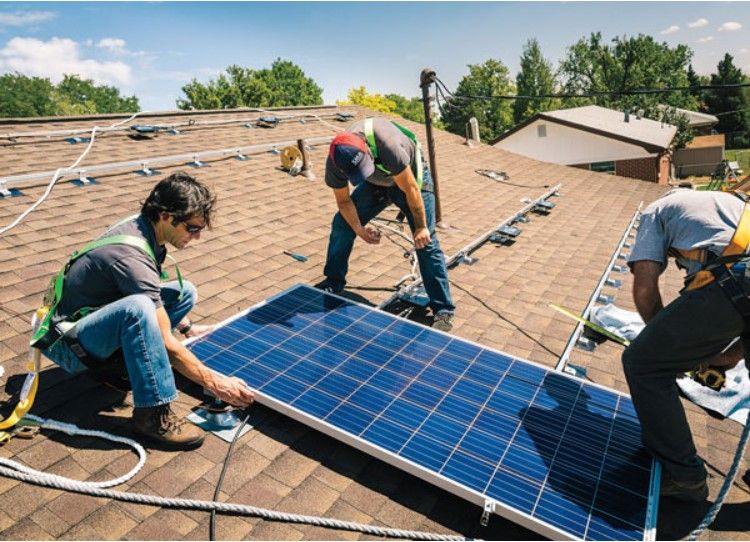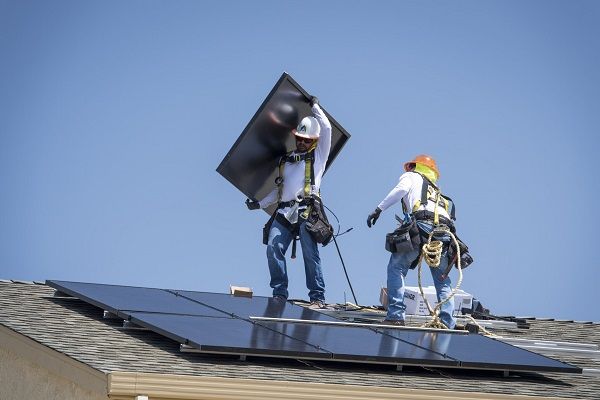Abbotsford Solar Installation
Best Solar Energy Company:
Innovating Commercial Solar Panel Solutions for Businesses
The need for sustainable energy sources prompts businesses to seek innovative solutions to reduce their environmental footprint. One of the most promising advancements in renewable energy technology is the development of commercial solar panel solutions. These cutting-edge systems offer businesses a multitude of benefits.
In this article, we will delve into the realm of innovative
commercial solar panel solutions. Let’s explore the latest technologies revolutionizing how businesses harness solar power.

What are Commercial Solar Panels?
Although solar power technology has been available for many years, numerous commercial enterprises still rely heavily on conventional electricity sources. Transitioning to solar power offers substantial benefits to businesses. Not only can it lead to cost savings, but it also has the potential to reduce carbon emissions.
Similar to a residential or home solar panel system, commercial solar panels harness abundant energy from sunlight. It converts the energy into electricity, effectively powering various buildings such as offices, factories, and warehouses.
Commercial solar panels are not limited to rooftops alone, a popular choice for residential installations. Commercial settings can still opt for roof installation, but commercial solar panels can be in various locations beyond rooftops.
For instance, parking lots can be solar carports, functioning as open-air garages with solar panel roofs. Another alternative is ground-mounted solar arrays, where panels are on the ground. Some solar panels can tilt and adjust their elevation throughout the day to maximize sunlight exposure during optimal hours.
Innovative Commercial Solar Panel Solutions
Innovative commercial solar panel solutions encompass the latest advancements and technologies revolutionizing businesses. These solutions surpass traditional solar panels, offering enhanced efficiency, versatility, and integration capabilities.
Solar Tracking Systems
A solar tracking system optimizes electricity production by moving the panels to align with the sun's position throughout the day. This adjustment maximizes the angle at which the panels receive solar radiation. Ground-mounted solar panels and large-scale solar installations commonly utilize solar trackers.
The angle at which sunlight hits the surface of solar panels, referred to as the "angle of incidence," directly affects the panel's ability to convert light into electricity. A narrower angle of incidence results in higher energy production from the photovoltaic panel. Solar trackers play a role in minimizing this angle by orienting the panels to face the sun directly.
Building-Integrated Photovoltaics (BIPV)
Unlike traditional solar panels that primarily generate electricity, building-integrated photovoltaics (BIPV) serves a dual purpose. It provides solar power generation and structural functionality to the buildings installed.
BIPV is a category of solar products integrated into the building's architecture, acting as an integral part of its structure. Most BIPV products are for large commercial buildings. Some exceptions demonstrate the growing popularity of BIPV in residential home construction.
The primary advantage of BIPV is the ability to harness additional solar energy from the sun. The potential is vast, considering that the solar energy hitting our planet is sufficient to power it 10,000 times over.
In addition to solar energy production, the aesthetic appeal of BIPV is a major attraction. BIPV offers a more subtle and streamlined approach to adopting solar power. This aesthetic advantage makes BIPV appealing to those who prefer a sleeker appearance. BIPV can also showcase a company's commitment to innovation and environmental consciousness in commercial settings.
Floating Solar Farms
Innovative installations mount solar panels on floating structures placed on bodies of water, creating floating farm solar panels. These solar farms use water surfaces to generate renewable energy while minimizing land space needs.
One notable benefit is the cooling effect. Solar panels operate best when kept within a certain temperature range. Floating solar arrays can provide an efficiency boost of approximately 5-6%. Immersing panels in water has shown even greater improvements, with some tests indicating an 11% efficiency increase.
Floating solar panels offer additional benefits beyond efficiency gains. When placed on a reservoir, for example, they provide shade to the water, reducing evaporation. This shading effect and decreased wind impact can save up to 90% of water.
Micro-Inverters and Power Optimizers
Microinverters are inverters installed directly at individual solar panel sites. The key characteristic of microinverters is their independent operation at the panel level, separate from other inverters in the system. This makes microinverters fall under the category of module-level power electronics (MLPE). MLPEs are particularly beneficial for complex installations.
Each panel with a microinverter works independently, ensuring efficient performance even if one panel generates less electricity than the others.
A power optimizer is an MLPE device that combines the functionalities of string and microinverters. It aims to enhance a solar panel system's energy output by continuously monitoring each solar panel's maximum power point tracking (MPPT). It adjusts the DC characteristics of the panels to maximize energy production. It improves system operation and allows for timely solar panel maintenance.
Bifacial Solar Panels
Bifacial solar panels can generate solar power from direct sunlight and reflected light. This sets them apart from the common monofacial solar panels that generate power solely from facing the sun.
The working principle of bifacial solar cells involves capturing both direct sunlight and albedo (reflected light) to generate electricity. Each bifacial panel can produce more electricity by harnessing albedo in addition to direct sunlight. This reduces the number of panels needed for a given installation.
Bifacial solar panels are constructed with transparent glass, allowing some light to pass through and reflect off the surface below. They use glass instead of metal frames or grid lines to increase the light passing through.
Bifacial panels often share the circuitry on the backside with the front side. This increases efficiency without requiring additional circuitry.

Install Innovative Commercial Solar Panels Today
Innovative commercial solar panel solutions offer businesses a range of benefits. Businesses can access cutting-edge technologies, from floating solar farms to building-integrated photovoltaics (BIPV) and advanced solar tracking systems. This access optimizes energy production, maximizes efficiency, and reduces their carbon footprint.
Embracing these innovative solutions helps businesses meet their energy needs and contributes to a more sustainable future. By leveraging the sun's power, businesses can drive positive change while enjoying the advantages of renewable energy.
Abbotsford Solar Installation offers diverse solar-powered systems tailored to your business's needs. Our team of professionals will guide the installation process, ensuring a seamless setup. If you are searching for the
best solar energy company, choose Abbotsford Solar Installation.
Embrace clean energy and make a positive impact on both your wallet and the environment.
